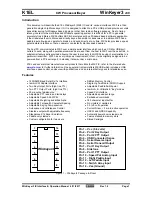
NVM Software Calibration Area Mapping
39.6. Functional Description
39.6.1. USB General Operation
39.6.1.1. Initialization
After a hardware reset, the USB is in the idle state. In this state:
•
The module is disabled. The USB Enable bit in the Control A register (CTRLA.ENABLE) is reset.
•
The module clock is stopped in order to minimize power consumption.
•
The is in suspend mode.
•
The internal states and registers of the deviceare reset.
Before using the USB, the Pad Calibration register (PADCAL) must be loaded with production calibration
values from the NVM Software Calibration Area.
The USB is enabled by writing a '1' to CTRLA.ENABLE. The USB is disabled by writing a '0' to
CTRLA.ENABLE.
The USB is reset by writing a '1' to the Software Reset bit in CTRLA (CTRLA.SWRST). All registers in the
USB will be reset to their initial state, and the USB will be disabled. Refer to the CTRLA register for
details.
The user can configure pads and speed before enabling the USB by writing to the Speed Configuration
field in the Control B register (CTRLB.SPDCONF). These values are taken into account once the USB
has been enabled by writing a '1' to CTRLA.ENABLE.
After writing a '1' to CTRLA.ENABLE, the USB enters device mode.
The USB can be disabled at any time by writing a '0' to CTRLA.ENABLE.
for the basic operation of the device mode.
Related Links
NVM Software Calibration Area Mapping
39.6.2. USB Device Operations
This section gives an overview of the USB module device operation during normal transactions. For more
details on general USB and USB protocol, refer to the Universal Serial Bus specification revision 2.1.
39.6.2.1. Initialization
To attach the USB device to start the USB communications from the USB host, a zero should be written
to the Detach bit in the Device Control B register (CTRLB.DETACH). To detach the device from the USB
host, a one must be written to the CTRLB.DETACH.
After the device is attached, the host will request the USB device descriptor using the default device
address zero. On successful transmission, it will send a USB reset. After that, it sends an address to be
configured for the device. All further transactions will be directed to this device address. This address
should be configured in the Device Address field in the Device Address register (DADD.DADD) and the
Address Enable bit in DADD (DADD.ADDEN) should be written to one to accept communications directed
to this address. DADD.ADDEN is automatically cleared on receiving a USB reset.
39.6.2.2. Endpoint Configuration
Endpoint data can be placed anywhere in the device RAM. The USB controller accesses these endpoints
directly through the AHB master (built-in DMA) with the help of the endpoint descriptors. The base
Atmel SAM L22G / L22J / L22N [DATASHEET]
Atmel-42402E-SAM L22G / L22J / L22N_Datasheet_Complete-07/2016
922
















































